Physics AQA A-Level Section 2 Waves and Optics: Chapter 4: Waves
1/122
There's no tags or description
Looks like no tags are added yet.
Name | Mastery | Learn | Test | Matching | Spaced |
|---|
No study sessions yet.
123 Terms
What are electromagnetic waves?
Oscillating electric and magnetic fields that propagate through space without need for a medium (Vibrating electric field → Vibrating magnetic field → Vibrating electric field etc.)
What are longitudinal waves?
Waves in which the direction of vibration of the particles is parallel to the direction of the propagation of the waves
What are some examples of longitudinal waves?
Sound waves
Primary Seismic waves
Compression waves on a slinky

What are the particle-dense areas of longitudinal waves called?
Compressions
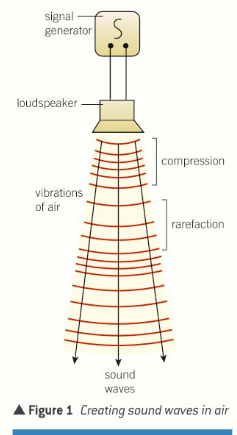

What are the non-particle-dense areas of longitudinal waves called?
Rarefactions
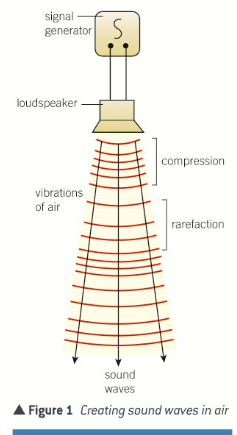
What are transverse waves?
Waves in which the direction of vibration of particles is perpendicular to the propagation of the waves

What are some examples of transverse waves?
Electromagnetic waves
Secondary seismic waves
Waves on a string or wire
When is a transverse wave said to be plane-polarised?
When the direction of vibrations and the propagation is limited to one plane only
What waves cannot be polarised?
Longitudinal
What happens when unpolarised light is passed through a polaroid filter?
The transmitted light is polarised, as the filter only allows through light which vibrates in a certain direction according to the alignment of its molecules
What happens when unpolarised light is passed through two polaroid filters?
The transmitted light intensity changes if one polaroid is turned relative to the other one
When transmitted light intensity is at a minimum, what are polaroid filters said to be?
‘crossed’
Why is light intensity at a minimum when the filters are crossed?
The polarised from the first filter cannot pass through the second filter as the alignment of molecules in the second filter is at 90° to the alignment of molecules in the first filter
What is the plane polarisation of electromagnetic waves defined as?
It is defined as the plane in which the electric field oscillates in
How do polaroid sunglasses reduce the glare of light reflected by water or glass?
The reflected light is polarised and the intensity is reduced when it passes through the polaroid sunglasses
What is meant by the displacement?
Distance and direction of a vibrating particle from equilibrium position
What is the definition of equilibrium?
A position of zero displacement
What is the definition of amplitude?
The maximum displacement of a vibrating particle
What is the definition of wavelength?
The least distance between two adjacent vibrating particles with the same displacement and velocity at the same time
What is the definition of one complete cycle of a wave?
From an area of Maximum displacement to the next maximum displacement (peak to peak, trough to trough)
What is the definition of a period of a wave?
The time for one complete wave to pass a fixed point
What is the definition of the frequency of a wave?
The number of cycles of vibration of a particle per second, or the number of complete waves passing a point per second measured in Hz
How does frequency affect wavelength?
The higher the frequency, the shorter the wavelength
What is the equation between frequency and time period?
f=1/T

If waves travel at a constant speed, how far does the peak of a wave travel in one second?
One wavelength
What’s the equation to link distance, speed and time?
Distance = speed/time
What’s the equation to calculate wave speed using wavelength and time period?
c=λ/T

What’s the wave equation?
c=fλ
What is the phase of a vibrating particle at a certain time?
The fraction of a cycle it has completed since the start of the cycle
What is the definition of phase difference between two vibrating particles at the same frequency?
The fraction of a cycle between the two vibrating particles measured in degrees or radians
How many degrees and radians is one wave cycle?
360 degrees (2π radians)
What’s the equation for phase difference in radians?
2πd/λ
What are wavefronts?
Lines of constant phase (e.g crests)
How does the direction of a wave compare with the wavefront?
The direction of a wave is perpendicular to the wavefront
What is the definition of reflection?
The return of waves from a surface
What is the angle of incidence equal to when an incident ray is reflected by a plane mirror?
Angle of incidence = Angle of reflection
Where is a normal line drawn?
Perpendicular to the surface
What is the definition of refraction?
The change of direction of a wave when it crosses a boundary where its speed changes
What happens when a wave travels across a boundary where its speed changes?
It’s wavelength also changes
What happens when wavefronts are incident to the boundary at a non-zero angle?
They change direction as well as speed
What is the definition of diffraction?
The spreading out of waves on passing through a gap or near an edge
How does the size of a satellite dish affect the strength of its signal and its ability
What is a wavelet?
A wavelet is a wave-like oscillation with an amplitude that begins at zero, increases or decreases, and then returns to zero one or more times.
Why are the waves diffracted on passing through the gap?
Consider each point on the wavefront as a secondary emitter of wavelets
The wavelets from the points along the wavefront only travel in the direction the wave is travelling and not the reverse direction
They combine to form new wavefronts, spreading beyond the gap
How does the size of the satellite dish affect the strength of the signal and the focus of the signal?
As the dish gets bigger, The stronger the signal it can receive because more radio waves are reflected off the dish onto the aerial.
A bigger dish reflects the radio waves to a smaller focus because it diffracts the waves less. So the dish needs to be aligned more carefully than a smaller dish
What is the definition of superposition?
At the point where waves meet, they combine for an instant before moving apart
What is the principle of superposition?
When two waves meet, the total displacement at a point is equal to the sum of the individual displacement at that point
What happens when a crest meets a crest and a trough meets a trough?
When a crest meets a crest, a super crest is created - the two waves reinforce each other
When a trough meets a trough, a super trough is created - the two waves reinforce each other

What happens when a trough meets a peak?
If they are the same amplitude, then the resultant displacement is zero
If they are different amplitudes, the resultant is called a minimum
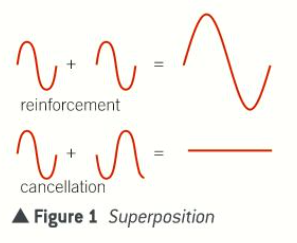
When are stationary waves formed on a rope?
If two people send waves continuously along a rope from either end.

What are the two sets of waves on either side of a stationary wave called?
They are called progressive waves to differentiate them from stationary waves
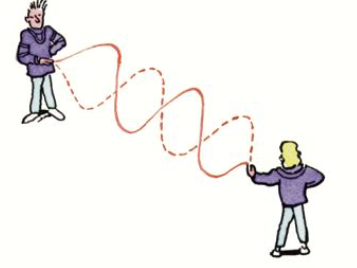
What do progressive waves combine to form at fixed points along the rope?
Nodes points of zero/no displacement
At each node how many degrees out of phase are the two sets of progressive waves?
180° out of phase so they cancel each other out so there is zero displacement (node)
How would you determine where there are points of cancellation in the wavefronts from a ripple tank?
A gap in the wavefronts shows there has been cancellation (crest meets trough or vice versa)

How are points of reinforcement created in a ripple tank?
A trough created from a vibrating dipper meets a trough from another dipper or crest meets crest

What causes the effect known as interference?
Waves are continuously passing through each other at constant frequency and constant phase difference
Therefore cancellation and reinforcement occur at fixed positions
The effect is known as interference
What do Coherent sources of waves do?
They produce an interference pattern where they overlap
This is because they vibrate at the same frequency with constant phase difference
What would happen if the phase difference of the progressive waves changed at random?
The points of cancellation and reinforcement would move about at random and no interference pattern would be seen
What can a microwave transmitter and receiver be used to demonstrate in waves?
Reflection
Refraction
Diffraction
Interference
Polarisation
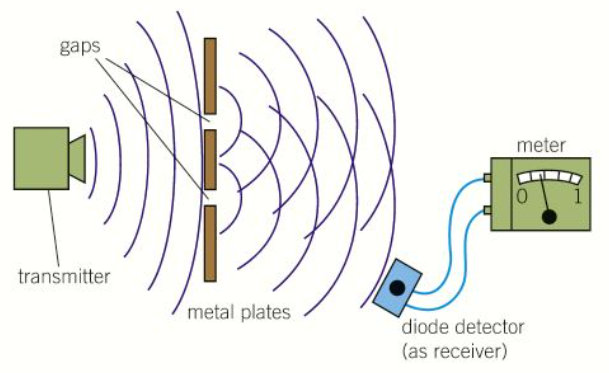
How would you show that microwaves become weaker as they travel away from the transmitter?
Place the receiver in the path of the microwave transmitter
Move it gradually away from the transmitter and note how the intensity drops as distance increases
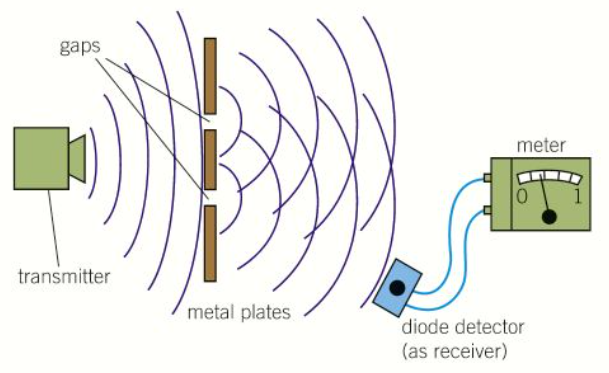
How would you show that microwaves cannot pass through metal?
Place metal plates between the transmitter and receiver
The reading on the receiver should be 0
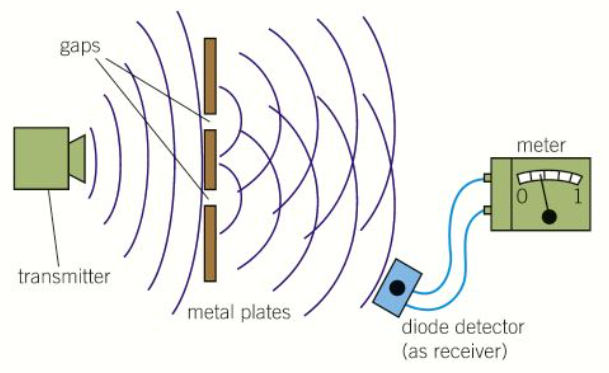
How would you show that microwaves diffract as they pass through a slit?
Use two metal plates to make a narrow slit and show that the receiver detects microwaves that have been diffracted as they pass through the slit
Show that if the slit is made wider, less diffraction occurs or vice versa
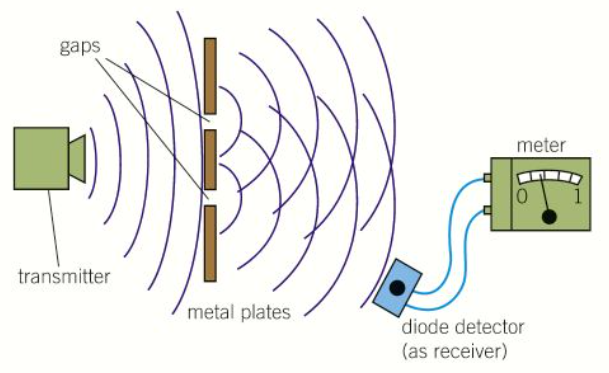
How would you show points of cancellation and reinforcement using microwaves?
Use a narrow metal plate with two plates above to make a pair of slits
Direct the transmitter at the slits and use the receiver to find points of cancellation and reinforcement where the microwaves from the two slits overlap
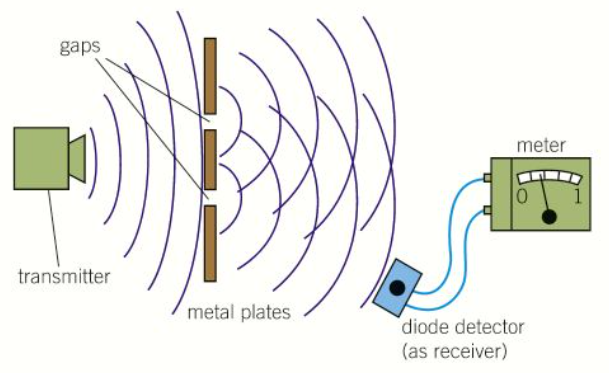
When are stationary waves formed?
When two progressive waves pass through each other
How can a stationary wave be formed on a string in tension?
By fixing both ends and making the middle part vibrate,
Progressive waves travel towards each end, reflect at the ends and then pass through each other
What is the simplest stationary wave pattern on a string called
The first harmonic (or the fundamental mode of vibration)

What does the first harmonic consist of?
A single loop that has a point of zero displacement at each end (node)
String vibrates with maximum amplitude between the nodes (antinode)

What is needed for the string to vibrate from side to side repeatedly in order to create the pattern of the first harmonic?
Distance between nodes at either end (i.e. length of string) must be equal to one half-wavelength of the waves on the string
Distance between adjacent nodes = 1/2λ
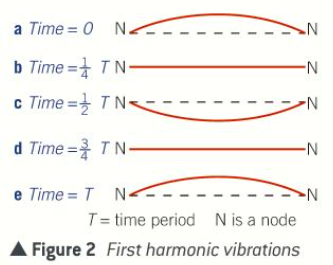
What happens if the frequency of the waves sent along the rope from either end is raised steadily from the first harmonic?
The pattern from the first harmonic disappears and a new pattern is observed with two equal loops along the rope
It has a node at the centre as well as either end
It is formed when the frequency is twice as high as in figure 2, corresponding to half the previous wavelength
Because distance between adjacent nodes = 1/2λ
Length of the rope is one full wavelength
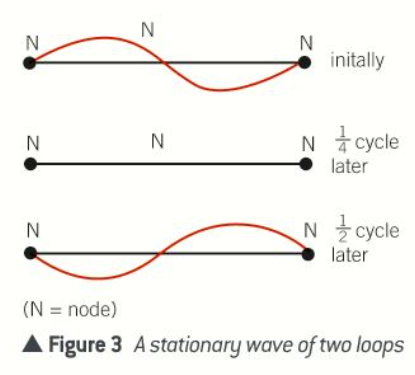
What is special about stationary waves that vibrate freely?
They do not transfer any energy to their surroundings, unlike progressive waves
This is because the amplitude of the vibration at their nodes is zero so there is no energy at the nodes
Amplitude of vibration at the antinodes is at a maximum so there is maximum energy at the antinodes
However, the nodes & antinodes are at fixed positions so no energy is transferred
When they are in phase, what do progressive waves do?
They reinforce each other to produce a larger wave

What happens to progressive waves ¼ of a cycle later after they were in phase?
They have moved one quarter of a wavelength in opposite directions
They are in antiphase so have cancelled each other out

What happens to the progressive waves ½ of a cycle later after they were in phase?
They are back in phase
The resultant is a large wave except in reverse direction

What happens at the nodes (point of zero displacement) that are fixed in position throughout
The stationary wave oscillates between the nodes. In general in any stationary wave pattern
How does the amplitude of a vibrating particle vary with position in a standing wave?
zero amplitude at node
maximum amplitude at antinode
How does the phase difference of vibrating particles vary between nodes?
Zero if the particles are between adjacent nodes or separated by an even number of nodes
180° (2π radians) if the particles are separated by an odd number of nodes
How does frequency of particles vary between Stationary and Progressive waves?
Stationary waves - All particles except those at nodes vibrate at the same frequency
Progressive waves - All particles vibrate at the same frequency

How does the amplitude of particles vary between Stationary and Progressive waves?
Stationary waves - Amplitude varies from zero at nodes to maximum at antinodes
Progressive waves - Amplitude is the same for all particles

How does the phase difference between two particles vary between Stationary and Progressive waves?
Stationary - equal to mπ where m is the number of nodes between the particles
Progressive - equal to 2πd/λ where d = distance apart and λ is the wavelength

How is sound in a pipe an example of a stationary wave?
Sound resonates at certain frequencies in an air-filled tube or pipe
In a pipe closed at one end, these resonant frequencies occur when there is an antinode at the open end and a node at the other end
How can you use microwaves to demonstrate stationary waves?
Microwaves from a transmitter are directed normally (90°) at a metal plate
The plate reflects the microwaves back towards the transmitter
When a detector is moved along the line between the transmitter and metal plate, the signal is found to be zero or minimum at equally spaced positions along the line
The reflected waves and waves from the transmitter create a stationary wave pattern
The positions where no signal (or minimum) is detected are where nodes occur
Nodes are spaced at intervals of half a wavelength (λ)
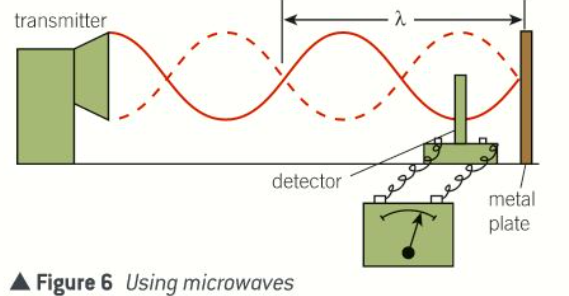
Describe a controlled arrangement for producing stationary waves [PROCESS]
String or wire tied at one end to a mechanical vibrator connected to a frequency generator
The other end of the string passes over a pulley and supports a weight which keeps tension in the string constant
As the frequency of the generator is increased from a very low value, different stationary wave patterns can be observed on the string
In every case, the length of the string between the pulley and the vibrator has a node at either end
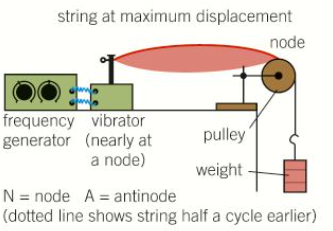
Where is the first harmonic pattern of vibration seen in the controlled arrangement for producing stationary waves?
Seen at lowest possible frequency that gives a pattern
Antinode in middle and node at each end
Since length, L of the vibrating section of the string is between adjacent nodes and distance between them is ½λ1
What is the wavelength of the waves that form the first harmonic pattern of vibration?
λ1 = 2L since distance between adjacent nodes is half a wavelength and Length of the string stays constant
λ/2 = L so 2L = λ
What is the equation for the frequency of the first harmonic?
f = c/λ1= c/2L, where c is the speed of the progressive waves on the wire
Also written as f1 for the frequency of the fundamental mode of vibration

Describe the second harmonic stationary wave pattern
There is a node in the middle so the string is in two loops
The wavelength of the waves that form this pattern is λ2 = L because each loop as a length of half a wavelength and there are two loops which, together, are equivalent to L

What’s the equation for the frequency of the 2nd Harmonic vibrations?
f2 = c/λ2 = c/L = 2f1 (twice frequency of first harmonic)

Describe the third harmonic stationary wave pattern
Nodes are at a distance of 1/3L from either end and an antinode in the middle
The wavelength of the waves that form this pattern is: λ3 = 2/3L because each loop has length of half a wave-length and there are 3 loops

What is the equation to find frequency of the third harmonic?
f3 = c/λ3 = 3c/2L = 3f1 (thrice the frequency of the fundamental mode of vibration)

How do stationary wave patterns form on a vibrating string? [PROCESS]
A progressive wave is sent out by the vibrator
Crest reverses its phase when it reflects at the fixed end and travels back along the string as a trough
When it reaches the vibrator, it reflects and reverses phase again so it travels away from the vibrator as a crest
If this crest is reinforced by a crest made by the vibrator, the amplitude of the wave is increased
This is how a stationary wave is produced
What is the key condition for a stationary wave to form?
The time taken for a wave to travel along the string and back should be equal to the time taken for a whole number of cycles of the vibrator
What’s the equation for the time taken for a wave to travel along the string and back?
t = 2L/c (where c is the speed of the waves on the string)
What’s the equation for the time taken for a vibrator to pass through a whole number of cycles?
t = m/f (where f is the frequency of the vibrator and m is a whole number)
How is the key condition for a stationary wave expressed?
2L/c = m/f (time taken for a wave to travel along a string and back is equal to the time taken for a vibrator to pass through a whole number of cycles)
Rearranging gives formula f= mc/2L and λ = c/f = 2L/m
What frequencies are stationary waves formed at?
f, 2f, 3f etc.
What is the length of the vibrating section of the string which produces stationary waves?
L = mλ/2 (a whole number of half wavelengths)
What does a pitch of a note correspond to?
Its frequency
How can a pitch of a note from a stretched spring be altered?
Changing the tension of the string
Altering its length
How can a vibrating string or wire be tuned to the same pitch as a tuning fork?
By changing length
By altering tension
How is the sound from a vibrating string different than the sound from a tuning fork?
Sound from a vibrating string includes all harmonic frequencies
Tuning fork vibrates at a single frequency